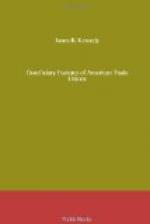[Footnote 213: Constitution, 1903 (St. Louis, n.d.), Article 23, p. 109.]
[Footnote 214: Constitution, amended, 1902 (Peoria, n.d.), sec. 52.]
[Footnote 215: Constitution, 1903 (Cedar Rapids, n.d.), Article 27, p. 86.]
Only a few of the unions paying benefits as distinguished from insurance make any such provisions. The Boot and Shoe Workers provide that the “sick and death benefit fund shall not be drawn upon for any purpose except for payment of sick and death benefits;” the Painters, that “no money received for a specific purpose shall be otherwise used;” and the Tobacco Workers, that “none of the funds shall be transferable one to another."[216] The Cigar Makers and the unions which follow its methods go quite to the other extreme.[217] All the moneys of the union are kept in a single fund and are drawn upon for the payment of benefits, organizing expenses, or strike pay, as need requires. In the great majority of unions, however, a nominal allocation of funds is practised. Thus, the Typographical Union in 1906 apportioned its monthly dues as follows: five cents to the general fund; five cents to the special defense fund; seven and one half cents to the defense fund; seven and one half cents to the burial fund; and ten cents to the endowment fund of the Union Printers’ Home. Similarly, the Iron Molders, the Boot and Shoe Workers, Painters, Pattern Makers, Barbers and many others apportion their dues in fixed ratios to specific objects. But such apportionments are mere book-keeping devices. None of these unions hesitate in an emergency to transfer money from one fund to another. The Iron Molders and the Printers, for example, give their executive board or council power to transfer money from one fund to another whenever occasion demands.[218] In the other unions there is an implied power. In 1899 the Executive Board of the Iron Molders transferred $10,000 from the surplus in the out-of-work fund to other funds, as follows: $3000 to the strike fund; $5000 to the expense fund, and $2000 to the monthly fund.[219] Similarly, the Typographical Union, from 1897 to 1902, transferred $24,174.64 from the burial fund to the general fund.[220] Although the Brotherhood of Carpenters do not make provision for the transfer of money from one fund to another, it has been found necessary to borrow from one fund in order to meet claims on another. In 1896 the Executive Board borrowed seven thousand dollars from the “protective fund” and twelve thousand from the “organization fund” with which to pay benefit claims.[221]
[Footnote 216: Constitution of the Boot and Shoe Workers’ Union, 1904 (Lynn, 1904), p. 25; Constitution of the Brotherhood of Painters, Decorators and Paperhangers of America, 1906 (La Fayette, n.d.), p. 39; Constitution of the Tobacco Workers’ Union, 1900, third edition, 1905 (Louisville, n.d.), p. 18.]
[Footnote 217: The following are the more important unions making no allocation of their funds: Cigar Makers, Typographia, Piano and Organ Workers, and Plumbers.]




